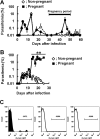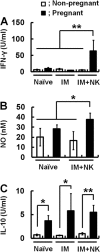Development of severe pathology in immunized pregnant mice challenged with lethal malaria parasites
- PMID: 23897619
- PMCID: PMC3811785
- DOI: 10.1128/IAI.00749-13
Development of severe pathology in immunized pregnant mice challenged with lethal malaria parasites
Abstract
Pregnant women are highly susceptible to malaria infection because of their low immunity and are at increased risk of maternal illness or death, in addition to spontaneous abortion, stillbirth, premature delivery, and low birth weight. However, the detailed pathogenesis of maternal malaria remains unclear. In this study, we evaluated a mouse model that shows similar severe pathological features of pregnant women during Plasmodium falciparum infection and investigated the pathogenesis of maternal malaria. Pregnant mice immunized by infection with an attenuated parasite, Plasmodium berghei XAT, were more susceptible to virulent P. berghei NK65 challenge/infection than were nonpregnant mice and showed high levels of parasitemia and a poor pregnancy outcome associated with placental pathology, such as accumulation of parasitized red blood cells, in the late phase of pregnancy. Notably, the pregnant immune mice challenged/infected with P. berghei NK65 developed liver injury associated with microvesicular fatty infiltration in late pregnancy. The pathological features were similar to acute fatty liver of pregnancy. Higher levels of gamma interferon and nitric oxide (NO) were found in plasma from pregnant immune mice infected with P. berghei NK65 than in plasma from nonpregnant mice. These findings suggest that development of liver injury and placental pathology in pregnant immune mice challenged/infected with P. berghei NK65 is accompanied by enhanced production of proinflammatory cytokines.
Figures







Similar articles
-
The association between acute fatty liver disease and nitric oxide during malaria in pregnancy.Malar J. 2021 Dec 14;20(1):462. doi: 10.1186/s12936-021-03999-2. Malar J. 2021. PMID: 34906158 Free PMC article.
-
Gamma interferon production is critical for protective immunity to infection with blood-stage Plasmodium berghei XAT but neither NO production nor NK cell activation is critical.Infect Immun. 1999 May;67(5):2349-56. doi: 10.1128/IAI.67.5.2349-2356.1999. Infect Immun. 1999. PMID: 10225894 Free PMC article.
-
Murine Model for Preclinical Studies of Var2CSA-Mediated Pathology Associated with Malaria in Pregnancy.Infect Immun. 2016 May 24;84(6):1761-1774. doi: 10.1128/IAI.01207-15. Print 2016 Jun. Infect Immun. 2016. PMID: 27045035 Free PMC article.
-
An alternative approach to malaria vaccine with a permanent attenuated mutant from a high virulence Plasmodium berghei strain.Zentralbl Bakteriol Mikrobiol Hyg A. 1987 May;264(3-4):319-25. Zentralbl Bakteriol Mikrobiol Hyg A. 1987. PMID: 3310458 Review.
-
Malaria in pregnancy: linking immunity and pathogenesis to prevention.Am J Trop Med Hyg. 2007 Dec;77(6 Suppl):14-22. Am J Trop Med Hyg. 2007. PMID: 18165470 Review.
Cited by
-
Babesia microti alleviates disease manifestations caused by Plasmodium berghei ANKA in murine co-infection model of complicated malaria.Front Cell Infect Microbiol. 2023 Jul 10;13:1226088. doi: 10.3389/fcimb.2023.1226088. eCollection 2023. Front Cell Infect Microbiol. 2023. PMID: 37492527 Free PMC article.
-
Malaria in pregnancy: the relevance of animal models for vaccine development.Lab Anim (NY). 2017 Oct 6;46(10):388-398. doi: 10.1038/laban.1349. Lab Anim (NY). 2017. PMID: 28984865 Free PMC article. Review.
-
Multi-system dysregulation in placental malaria contributes to adverse perinatal outcomes in mice.Infect Immun. 2025 Jul 8;93(7):e0002125. doi: 10.1128/iai.00021-25. Epub 2025 Jun 5. Infect Immun. 2025. PMID: 40470930 Free PMC article.
-
The association between acute fatty liver disease and nitric oxide during malaria in pregnancy.Malar J. 2021 Dec 14;20(1):462. doi: 10.1186/s12936-021-03999-2. Malar J. 2021. PMID: 34906158 Free PMC article.
-
Multi-System Dysregulation in Placental Malaria Contributes to Adverse Perinatal Outcomes in Mice.bioRxiv [Preprint]. 2025 Jan 15:2025.01.15.633265. doi: 10.1101/2025.01.15.633265. bioRxiv. 2025. Update in: Infect Immun. 2025 Jul 8;93(7):e0002125. doi: 10.1128/iai.00021-25. PMID: 39868257 Free PMC article. Updated. Preprint.
References
-
- World Health Organization 2011. World malaria report 2011. World Health Organization, Geneva, Switzerland
-
- Steketee RW, Nahlen BL, Parise ME, Menéndez C. 2001. The burden of malaria in pregnancy in malaria-endemic areas. Am. J. Trop. Med. Hyg. 64:28–35 - PubMed
-
- Dreyfuss ML, Stoltzfus RJ, Shrestha JB, Pradhan EK, LeClerq SC, Khatry SK, Shrestha SR, Katz J, Albonico M, West KP., Jr 2000. Hookworms, malaria and vitamin A deficiency contribute to anemia and iron deficiency among pregnant women in the plains of Nepal. J. Nutr. 130:2527–2536 - PubMed
-
- Kahigwa E, Schellenberg D, Sanz S, Aponte JJ, Wigayi J, Mshinda H, Alonso P, Menéndez C. 2002. Risk factors for presentation to hospital with severe anaemia in Tanzanian children: a case-control study. Trop. Med. Int. Health 7:823–830 - PubMed
-
- Menéndez C. 1995. Malaria during pregnancy: a priority area of malaria research and control. Parasitol. Today 11:178–183 - PubMed
Publication types
MeSH terms
LinkOut - more resources
Full Text Sources
Other Literature Sources
Medical

